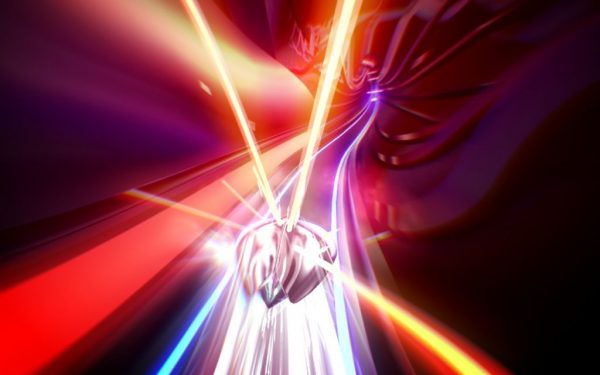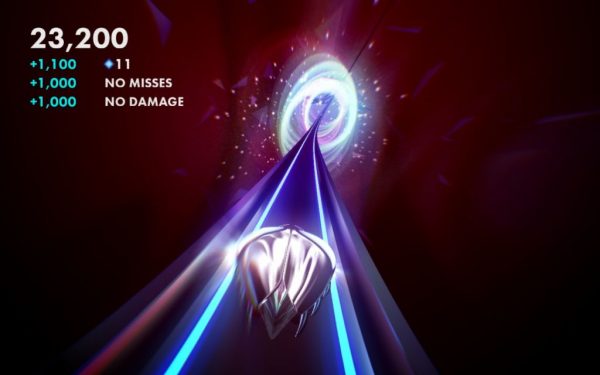Also on: PS4, PSVR
Publisher: Drool
Developer: Drool
Medium: Digital
Players: 1
Online: None
ESRB: E10+
Rhythm games took a while to come into their own, starting out with a Simon Says model back in the days of PaRappa and Space Channel 5. It’d be fair to say they’ve even had a few heydays, peaking most recently with the Guitar Hero craze– playing instruments in time with dropping bars. Beatmania was doing that kind of thing for ages, but couple with plastic replica instruments, and the rest was history. Heck, even Amplitude’s lane-hopping beat keeping predated the peripheral craze, and along with it, popularized a model for rhythm-based gameplay.
Fact is, we love having our notes come to us.

This is where Thumper joins the mix, doubling down on the stress of hitting or missing notes. Song complexity is then simplified by dialing down the number of active lanes to one, bludgeoning players with basic articulation on a one-track avenue of dread. Rather than a landscape of celebratory avatars or strobing lights, players look ahead to see undulating abstractions and tight corridors. This is the rhythm game Thumper wants to play. This is a music game with menace.
While Thumper’s difficulty will vary in challenge between players, the introductory levels do a fine job of introducing new mechanics for users to practice over the course of each level’s dozen or so tracks. Players are taught simple mechanics, such as getting a feel for hitting the right note, and later more complex ideas such as steering off banked curves so as not to take damage, or flying above spikes so as not to take damage, or hitting notes under supervision of a looming laser grid waiting hungrily for your first mistake– prompting an assault, and of course taking damage.

It doesn’t take long to discover that while Thumper shares some very basic DNA with rhythm games, it’s one of the most defensive versions that you’ll ever play. This is accentuated by the soundtrack itself, a highly percussive, rhythmic drumming that borders on pounding at times. Music is used to more than effect, however, as certain cues will indicate upcoming obstacles– but in the continuous stream of gameplay that links tracks across their 15-20 minute levels, Thumper relies on patterns and sound to communicate its design to those willing to tune in.
Failure is expected, and with a two-hit damage system, players aren’t immediately destroyed when failing a sequence. Skilled players can use notes to their advantage, retrieving their shielded state when collecting enough points or completing a level’s track. Another noted difference between areas is how failure is treated between regular gameplay and boss fights. When dying on a track, players are quickly respawned, but in fights, the looping soundtrack allows for circular segments that will repeat until perfected, or players die. This is a nice way if addressing progression in what could be called combat, as players are given soft checkpoints– reliable until death.

While I appreciate that there are some folks who will put in the effort of S-ranking the entire game, certain aspects (such as the overload of visual effects when taking damage or nailing a combo) tend to distract from other present and dangerous obstacles on a track, resulting in a sense of being sucker-punched when things were going so well, or usually, when you were just barely hanging on. It’s not clear what the intent was in these cases, although it could be a bad combination of elements, but Thumper is at times too stylized, and that detracts from the overall experience. Especially when the experience relies so heavily on responding to escalating threats while whipping through a track.
Thumper stresses me out, there’s no question about it. The difference is how its tight design justifies the challenge presented– rather than being difficult for the sake of reputation. A large part of Thumper is also the atmosphere, of which the dark tone is more refreshing than anything else in the rhythm genre. It’s psychological, or at least intimidating, and can even wear down your focus after an hour or so. There’s nothing else quite like it, however, and for fans of music games or cool indie projects, this one’s worth taking for a spin.

